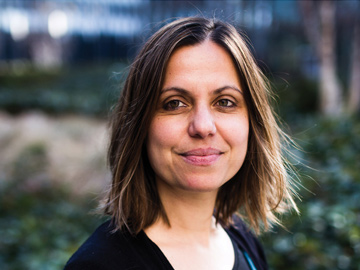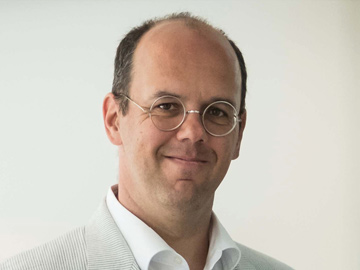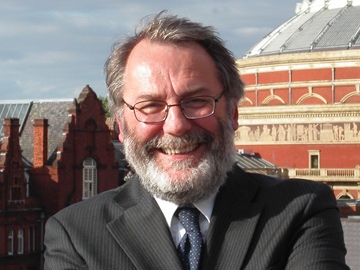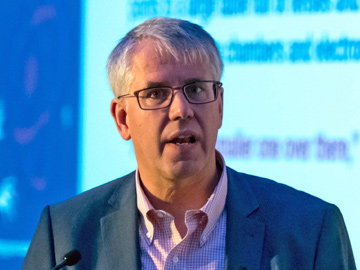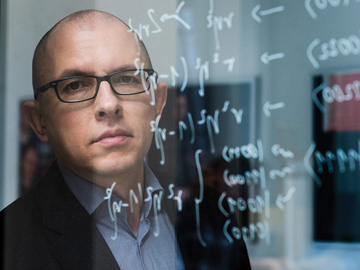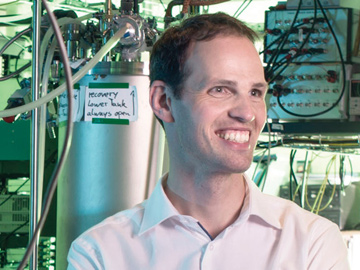 [Getty Images]
[Getty Images]
“The next 10 years in quantum technology are going to be extremely exciting in Europe.”
—Eleni Diamanti[Photo by Claire Gaby]
It’s a busy time for Eleni Diamanti, a professor of quantum communications at CNRS and Sorbonne University in Paris. Outside of the lab, she shuttles between meetings of steering committees for France’s national research group on quantum technologies and for SIRTEQ, a quantum-tech effort of the Île-de-France region. She’s vice director of the Paris Center for Quantum Computing, which in turn participates in the pan-European Quantum Internet Alliance. And she sits on a scientific committee set up by the French Ministry of Higher Education to promote France’s role in the Quantum Flagship, a billion-euro, 10-year European Union (E.U.) program launched in 2017 to support quantum technology.
Despite the hectic schedule—or maybe because of it—Diamanti remains an unabashed optimist about her science and its place in her country and continent’s future. “My opinion,” she says, “is that the next 10 years in quantum technology are going to be extremely exciting in Europe.”
The optimism seems well founded. One reason is the launch of the Flagship initiative, a key E.U. endorsement and support vehicle that Diamanti calls “a turning point in Europe for quantum technology.” And complementing that Europe-wide effort is a constellation of E.U. member-state programs to advance quantum science. These efforts aim to put Europe and its constituent nations at the forefront of the international race to move quantum from lab to marketplace—and to reap the benefits that result.
Worldwide, the air is full of talk of a “second quantum revolution,” in which the ability to control and leverage “quantum weirdness” like entanglement and superposition will finally start to play out in real products and services like next-generation computers, encryption and sensors. As a result, government research programs, not only in Europe but in societies ranging from China and Singapore to Canada and the United States, have started to coalesce around the quantum theme. All of that activity should prove good for photonics, as photons underlie both the enabling technologies (such as narrowband laser and RF sources) for quantum research, and many of the envisioned new devices and systems, such as satellite laser-based quantum communication, that will take advantage of “the quantum difference.”
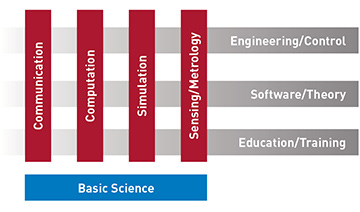 Strategic research structure of the Quantum Flagship. [Source: European Commission]
Strategic research structure of the Quantum Flagship. [Source: European Commission]
Maiden voyage
The Quantum Flagship in particular has galvanized Europe’s research community. The program is one of three Future and Emerging Technologies (FET) Flagships—big thematic funding efforts selected by the European Commission (E.C.), under the E.U.’s current funding framework program, Horizon 2020, to address “grand challenges” in emerging science and technology. Each flagship program has a life span of around 10 years and a total budget of around €1 billion, half from E.U. funds and half from member-state and industry contributions. (In addition to quantum, two other flagships, launched in 2013, support brain research and research in applications using graphene.)
Tommaso Calarco of the University of Ulm, Germany, a key figure in the Quantum Flagship’s genesis, says that a main goal of the FET Flagships is to “fill the gap between research and innovation” and to facilitate “translation from the lab to the market.” He explains that while “scientific excellence is very widespread in Europe,” the continent has not always been its main commercial beneficiary. He cites the example of the World Wide Web: “It was developed at CERN in Europe,” he observes, “but the wealth that was created came mostly in the United States.”
The Quantum Flagship in particular will support applications research proceeding along four tracks or “pillars”—communication, computation, simulation, and sensing/metrology—enabled by advances in engineering, software and theory, and education. The four pillars sit atop a horizontal cross-cutting foundation of basic science. Calarco stresses that building the Flagship has been “a strongly bottom-up process,” premised on ongoing input from key quantum researchers and technology stakeholders from all E.U. member states. That process, he says, helps ensure consistency between the Flagship research agenda and those of the community working on quantum problems across Europe.
Steering the Flagship
Right now, the Quantum Flagship is in its “ramp-up” period. On 8 June the program announced that it had completed selection of its first-round projects, after a call that attracted 140 separate proposals; public announcement of the winning proposals will likely come late this summer, after contract negotiations between research teams and the E.C. That announcement should clarify the Flagship’s near-term course.
In the longer run, where the Flagship will sail is a bit more of an open question—and depends, in part, on the firmness of the hand on the tiller. Ronald Hanson, of the QuTech advanced research center of Delft University of Technology and the Netherlands Organization for Applied Research, points out that the E.C. could take any number of approaches between two end-members.
“The E.C. and member states are giving a lot of attention [to] strategies and policies for international cooperation.”
—Tommaso Calarco[Photo courtesy of European Forum Alpbach/Bogdan Baraghin]
“We are at a special moment in time, in which the E.C. can take the leap from research in labs into technology development and eventual real-world benefits,” he says. “Taking this leap can be compared to the first moon mission. One approach to this mission could be that you distribute the resources over the many good research groups in Europe; everybody gets a little bit of money and makes a little bit of progress. Or, on the other extreme, you have a fully top-down, orchestrated effort.”
Hanson says he’d prefer something closer to the latter—a “strong, mission-driven program where Europe can achieve something,” rather than potentially diluting the Flagship’s impact by spreading it among too many relatively small projects. But a mission-driven approach doesn’t preclude the potential for smaller-scale wins as well—whether funded through the Flagship or some other mechanism.
“How many resources should be put into a single goal, and how much should be spent on looking around and seeking new applications, is a really big question,” says Konrad Banaszek of the University of Warsaw, Poland. “There may be some low-hanging fruit in fixed-scale applications that can be reached with relatively moderate effort. These, I think, should be identified and supplied with suitable funding.”
Calarco also notes the Quantum Flagship’s potential to help make the E.U.’s smaller states more competitive. The Flagship’s bottom-up approach to the research agenda and its emphasis on collaborative projects, he suggests, give member states the flexibility to aim their programs where they can get the most bang for the buck. Calarco cited the case of Hungary, which is targeting its comparatively small national research endowment at strengthening its program in basic science and research. That, says Calarco, will allow its scientists “to become even more strongly competitive” and attractive to the multinational research consortia competing for big Flagship projects.
“We had very firm instructions from government ministers that [the U.K.] shouldn’t be playing catch-up at all.”
—Sir Peter Knight[Photo courtesy of OSA]
Quantum sensors
While exotic next-gen computers tend to be the most talked-about outcome of quantum technology, most researchers believe that general-purpose quantum computers are at least 10 years away. But the journey to them, says Sir Peter Knight of ICL, “has outcomes that also are technologically relevant,” and potentially of economic value. One example: quantum sensors.
“One of the reasons that quantum computing is really hard is you’re trying to get these quantum bits together and manipulate them, and they’re unbelievably fragile—they interact incredibly strongly with their environment,” says Knight. “Well, that’s exactly what you want from a sensor.” Quantum gravity sensors employing laser-cooled atoms as qubits, for example, could open up new opportunities for imaging the subsurface in areas, such as Knight’s home city of London, that have dense, complex underground infrastructure.
The U.K. initiative
As these examples suggest, the Flagship is not the only quantum game in Europe. Overall, programs in individual member states together account for a much larger slice of the region’s funding for quantum research. That funding, like the Flagship, will be crucial in advancing the fortunes of both Europe and its individual countries in the worldwide quantum technology business.
Among those state initiatives, many view the United Kingdom’s National Quantum Technologies Programme (NQTP) as a lodestar. “I have to give highest credit to the U.K. and its quantum technology program,” says Wilhelm Kaenders, a president of the German photonics firm Toptica. “The conjunction of the political need to identify positive economic momentum, a strong interest in developing a national defense and security capability, and very wise academic guidance … allows for a good mixture of short-term funding with long-term expectancy.”
A senior figure in moving NQTP forward has been 2004 OSA President Sir Peter Knight of Imperial College London (ICL). He notes that the early effort hinged on identifying the U.K.’s biggest strength areas in quantum. “We had very firm instructions from government ministers,” says Knight, “that we shouldn’t be playing catch-up at all.” One milestone in the road toward NQTP, says Knight, was a 2012 conference that he helped organize at Chicheley Hall in Buckinghamshire, where the participants hashed out those existing strengths, and the resources and time needed to take them further.
Two years and a good deal of on-the-ground advocacy later, NQTP was born, with a government commitment of new funds amounting to £270 million (€305 million at current exchange rates) for the five years beginning in 2013. Knight says that the program’s total funding has since expanded to some £400 million (€452 million) including coinvestments from the U.K. National Physical Laboratory, the Ministry of Defense, and other sources—such as the U.K. Industrial Strategy Challenge Fund, which emphasizes technology transfer from research to applications.
NQTP’s focus on industry and technology transfer has become even more explicit with the current efforts to extend the program for another five years. Knight has authored a paper laying out the vision for the program’s phase two. In that phase, he says, “the balance between funding inquiry-driven research and what we’re spending on the translational side of it will change quite a lot,” with a greater emphasis on supporting entrepreneurship and marketplace innovation. In recent testimony before a select committee of the British House of Commons, Knight and David Delpy of University College London, the chair of the NQTP strategic advisory board, argued for a new five-year funding commitment of £338 million (€382 million). A decision is expected in September 2018.
On the continent
Across the Channel, European national governments are pushing a mosaic of quantum programs with different scopes and emphases. The Netherlands, for example, has put significant resources into quantum information technology, through its support of the QuTech research center at Delft. QuTech’s Ronald Hanson says that the road to the institute started 15 years ago, when the Dutch national funding agency awarded a 10-year grant to researchers at TU Delft and Leiden University to “start exploring the building blocks of quantum technologies.”
By the end of that first program, says Hanson, “we were far enough that we could say, we physicists cannot do it alone anymore. We need other players”—particularly engineers, with backgrounds ranging from optical and electrical engineering to computer science. Identifying that need led to the 2014 establishment of QuTech—a dedicated advanced research center for quantum information and technology, “where the engineers and scientists really get together in one place,” according to Hanson. The institute was funded with a €135 million, 10-year commitment from the Dutch government.
A measure of the government’s confidence in the effort is that the 10-year baseline funding for QuTech has no specific milestones for deliverables. “The stakeholders were happy to have this new institute where engineering and science were connected,” says Hanson, “and to push things forward very hard.” The idea, he says, was “that this would evolve into a technology and an ecosystem that could be very useful to the Netherlands.”
“National interests exist, but the challenges are so high that cooperation is the key to progress.”
—Wilhelm Kaenders[Photo courtesy of OSA]
In Germany, meanwhile, Toptica’s Wilhelm Kaenders says that—after being “severely held up” by the difficulties in forming a post-election coalition government in fall 2017—the quantum program has gathered steam. One sign of the government’s interest came in mid-June hearings of the Digital Agenda Committee of the German parliament. There, seven industry and academic scientists—including several from the Netherlands and the United Kingdom—spoke on quantum tech’s future role and the international activity emerging there.
“Rumor has it that we will see a significant tax-paid program”—perhaps on the order of €300 million or more, for three or four years—from these efforts, according to Kaenders. That program will flow from multiple different funding streams, including the country’s Ministry of Education and Research, which focuses more on technology transfer of academic research; the Ministry of Economic Affairs; the well-known Fraunhofer Institutes (which are relatively new to quantum, but which, according to Kaenders, are boosting their game); and commercial enterprises, which would contribute their own funds to add to the political program.
The various funding streams spring from the country’s Verbundforschung model, which involves joint collaborative activity of multiple partners and joint financing from the public and private sectors. “Germany has had very good experience with such a collaborative approach in the past,” according to Kaenders.
Niche programs
Not all member-state programs in Europe are as large as those in the U.K., the Netherlands and Germany. In France, notes Eleni Diamanti, the government’s commitment “cannot really compare with the U.K., where they’ve put a lot more money on the table.” Even so, the French National Research Agency (ANR) has done specific calls for quantum proposals, at a total level of €10 million per year for the 2018-2020 period. And regional initiatives kick in additional funds—such as €10 million across four years from SIRTEQ, a quantum-technologies project supported by Diamanti’s own Île-de-France region, and similar programs in Grenoble and Nice.
Diamanti argues that these national funds, while small compared with the Flagship, play an important role. “Everybody knows by now that not all efforts can be funded” through the E.U. project, she notes. “The national programs can cover areas that could not be supported in the Flagship—taking into account the strengths of each country.” For France, she says, those strengths lie particularly in basic, enabling science. But it also has strong traditions and research groups in quantum communications and cryptography, the focus of Diamanti’s lab, and in other areas such as atomic physics, single-photon sources and quantum algorithms.
“There may be low-hanging fruit in fixed-scale applications that can be reached with relatively moderate effort. ”
—Konrad Banaszek[Photo by One HD, courtesy of the Foundation for Polish Science]
Poland is also building on its strengths to boost its quantum program, according to Konrad Banaszek. An important milestone came in 2017, when the E.C. tapped the National Science Center Poland (NCN) to coordinate the QuantERA program, a small-scale precursor to the Quantum Flagship under the E.U.’s European Research Area (ERA-NET) scheme. That was an acknowledgment that NCN had matured to the point that it could take on a major managerial project—“a kind of coming-of-age,” according to Banaszek.
This year, using E.U. money managed by the Foundation for Polish Science, Poland is establishing two dedicated quantum research centers—one at the University of Gdansk, which Banaszek says has a strong reputation in the underlying theory of quantum information and entanglement, and one in Banaszek’s home institution, the University of Warsaw, which has complementary capabilities in experimental quantum optics and photonics. In the long run, he believes, the effort should contribute to Poland’s economic growth.
“This is an opportunity that’s offered by new research directions,” he says. “Instead of catching up with well-established fields that require large infrastructure, we can contribute to science starting new fields … I think this is a great opportunity for countries in Central and Eastern Europe.”
Industry’s role
These examples only scratch the surface of Europe’s national quantum programs. Numerous other European states, including Denmark, Italy, Austria, Spain, Switzerland, Sweden and Finland, are developing their own country-specific quantum programs and boast strong research groups in a variety of quantum niches.
“Partnerships [with industry] are crucial ... These are huge technologies and will involve collaboration between many players.”
—Ronald Hanson[Photo courtesy of TU Delft]
Eyeing a quantum internet
One of the 140 proposals submitted in the European Quantum Flagship’s first funding round came from a pan-European consortium, the Quantum Internet Alliance (QIA). The consortium includes 13 leading European quantum research centers and 12 industry partners, spearheaded by QuTech in Delft, Netherlands.
The purpose, says QuTech’s Ronald Hanson, is to bring Europe’s best research groups and industry players together to “advance the mission of a quantum internet.” Eleni Diamanti, whose Paris Center for Quantum Computing at CNRS is one of QIA’s partner institutions, says the team hopes to look at the end-to-end requirements for a quantum network—“everything from the physical layer, developing actual devices … up to a real network stack” and associated software. The project’s goal would be a small-scale demonstration to show the feasibility of such a quantum internet.
Why chase that target? Diamanti notes that the near-term arguments relate largely to improved cryptography and security. But she says that—in much the same way that some algorithms that may benefit from quantum computers won’t be known until the machines are a reality—a quantum internet, once it’s in place, may reveal prospects for “further applications that we don’t even know now.”
Whether through national programs, pan-European consortia or the Quantum Flagship, academia–industry connections form a vital part of the recipe for developing Europe’s quantum edge. “I think these partnerships [with industry] are crucial,” says Ronald Hanson of QuTech, which has actively forged links with firms such as Intel and Microsoft on specific projects. “They are essential to make something happen … A research institute like QuTech cannot claim to build a quantum computer or a quantum internet on its own. These are huge technologies and will involve close collaboration between many players.”
Still, while companies like Google, Microsoft and IBM are investing hundreds of millions of U.S. dollars into quantum computing, Eleni Diamanti says that other companies, even in photonics, have historically not viewed quantum as a technology ripe for investment. But she believes that’s changing. One bellwether of the change, she suggests, is quantum’s place in Photonics21, the European technology platform and public-private partnership (PPP) initially formed in 2005 to advance photonics as a key enabling technology (see Viewpoint).
“It’s very interesting, and quite revealing, how quantum technologies have evolved within Photonics21 and the PPP,” says Diamanti. “Until very recently, anything close to quantum technologies were put in the [Photonics21] working group on education and emerging technologies. Now, we find topics related to quantum technologies in the other, ‘main’ working groups. You see a bit of quantum security in the group on information and communications technologies; a bit of quantum sensing in the group on sensors; a bit of quantum photonics in the integrated-photonics group.”
That pattern in Photonics21, she suggests, could point to a growing appreciation of quantum’s potential in the photonics industry. Diamanti is seeing this in France, where she says industry could sometimes be characterized as “risk averse.” But now, her lab and others are forging joint projects and Ph.D. programs with French companies, such as the information-tech giant Atos.
Looking abroad
These activities in Europe, and numerous others not mentioned, form just one component in the global quantum picture. China’s quantum effort, the scope of which is unclear but which is thought to encompass many billions of U.S. dollars in research spending, looms large in many discussions, as do the efforts in Japan, Canada’s “Quantum Valley,” and other areas. Several sources mentioned the recent U.S. effort to build a national quantum initiative, embodied in legislation introduced this summer in the U.S. Senate and House of Representatives. “It will be interesting to see how the U.S. picks this up,” says QuTech’s Ronald Hanson, “and how the U.S. and Europe can learn from each other.”
Tommaso Calarco of Ulm stresses that the international interaction need not always be competitive. “This is a topic,” he says, “that the E.C. and member states are giving a lot of attention—strategies and policies for international cooperation.” While recognizing the need to protect the intellectual property required for value creation, he sees a lot of potential for global cooperation in “scientific pre-competitive, pre-industrial development of knowledge.” Wilhelm Kaenders of Toptica agrees. “National interests exist,” he says. “But the challenges are so high that cooperation is the key to progress.”
And notwithstanding the uncertainties surrounding Brexit (see Brexit: Two Years Later), ICL’s Peter Knight believes the U.K.’s “very strong European collaboration” can continue as well. He notes the role that British researchers (including 2018 OSA President Ian Walmsley) have already played in developing E.U. quantum programs, and the U.K. prime minister’s expressed desire to continue to contribute to and participate in E.U. research programs. “That is a really positive sign,” he says. “So I believe we’ll still be there, in terms of the European program.”
It all adds up to a very interesting period ahead for quantum technology, in Europe and around the world. And, according to Eleni Diamanti, it “puts lots of responsibilities on researchers in the field” to move quantum from the lab to the commercial sphere.
“We’ve been given significant means to do that—to pair with industry and actually bring this to real products and services for people,” she says. “Now we are at the point where we need to deliver.”
Stewart Wills is OPN’s senior editor.
References and resources are at www.osa-opn.org/euroquantum.

